Not too long ago, on 2 October the Hindi film fanatics were treated with the release of two big budgeted and multi-cast films. One being the Hrithik Roshan and Katrina Kaif starrer ‘Bang Bang’ and the other being Vishal Bhardwaj’s adaptation of ‘Hamlet’ starring Shahid Kapoor as Haider.
Well, AnimationXpress.com got the opportunity to have an exclusive interaction with the VFX supervisor and Digikore Studios, who worked on giving ‘Haider’ the period look and also to help in creating the right visual effects to support the narrative of this film on love and betrayal.
The story is of a young man who returns home to Kashmir on receiving news of his father’s disappearance. But, not only does he learn that security forces have detained his father for harbouring militants, but also that his mother (Tabu) is supposedly in a relationship with his very own uncle (Kay Kay Menon). Soon Haider learns that his uncle is responsible for the gruesome murder of his father, and what follows is his journey to avenge his father’s death.
Excerpts:-
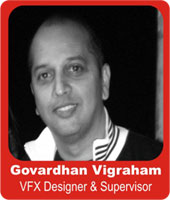 Govardhan Vigraham (Second Unit director and VFX Designer on ‘Haider’)
Govardhan Vigraham (Second Unit director and VFX Designer on ‘Haider’)
Q. You have been associated with earlier projects of Vishal Bhardwaj, so how different was this one from them?
I’ve been associated with Vishal from Kaminey, and I’ve worked in every film he’s made since then. It has always been an enjoyable experience, and a great environment to work in. In Haider, apart from being the VFX Designer, it was a pleasure to be the 2nd Unit Director too. It was a great experience.
Q. How many artists worked on the project and how many VFX shots were required in the film? What sort of composites and effects has been used in the film, please elaborate?
In the timeframe that we had to finish the job, the team size required was like a decent one. In Digikore, because they have recently started the setup in Mumbai the required number of artists for the project was not sufficient – but they were able to scale up the team from 20 to 55 people in a very short span of time. There were around 350 shots to be delivered in two months of time.
Haider has practically everything that VFX can do in a film – multi-layer compositing, CGI, complex clean-ups. We also had to recreate a period look dating back to mid 90s. What was special about Haider was that the effects had to be invisible; it could not be in-your-face kind of noticeable effects.
This being a film shot entirely in Kashmir, we knew from the start that VFX would play a crucial role in effectively creating the awe that was so integral to the script. We needed to blow up structures, show our lead actors in some very difficult-to-shoot locations, use CG stand-ins, complex clean ups, and many more complex work.
There are so many scenes that could be spoken about, but the following could be the key scenes that need a special mention:
1) The crackdown scene – blowing up of Haider’s father’s mansion
For this scene, the art department had built a real scale set on location. This was quite a large structure, and this needed to be blown up by the rocket fired by the army. To try to actually blow up such a large, real structure was obviously a hazardous and a daunting task.
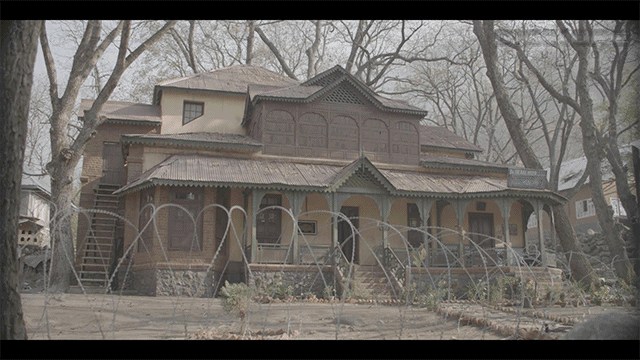
VFX Solution:
As a solution, the art department built a perfect replica as a miniature, which we then exploded in Mumbai on Green Screen.
In VFX, we composited this layer over the live plate, and added several layers of additional material – additional splinters, smoke, dust, fire, etc. We also composited the barbed wire fence over the whole layer to give a sense of scale, and this one layer had such an immense impact on the scale – the miniature looked that much more large and imposing.
2) Haider’s introduction shot
This introduction shot required the actor, Shahid Kapoor, to be sitting at the window-seat, looking out, as the bus emerges from the tunnel. This would normally seem like an easy, non-challenging shot to pull off. However, it was indeed a challenge to do this for real. It was more a logistic driven issue than technical or creative. This tunnel was a five hour drive, one-way, from our base location, Srinagar. So effectively, we would have transported an entire crew and cast, and spent the whole day to do just that one shot!
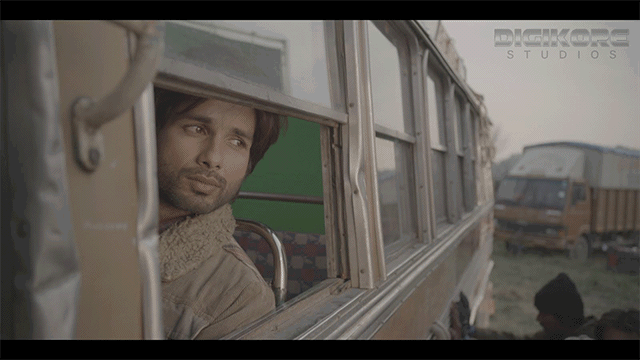
VFX Solution:
As a solution, I travelled with a relatively smaller crew and support cast, to the tunnel, and took a plate (without Shahid in the bus of course). I had the camera rigged to the window, and took two passes.
First pass – I kept the window open so we could see the passengers inside, and also the exterior of the bus and the tunnel.
Second pass – I had the window closed, and covered it with a black cloth from the inside. This enabled me to get a clean reflection on the window pane, without any of the interiors showing through.
We then returned to Srinagar where Shahid was shooting other scenes, to shoot his layer. For this, I had the camera rigged in the exact same spot on the bus, and the actor sat in the seat against a green screen.
Using VFX we composited Shahid’s layer over the bus layers. We used the reflection pass to simulate the window pane reflection. This gave us tremendous control over the composition – enabling us to control the amount of reflection, timing his expression to perfectly match with the moment when the bus emerges from the dark tunnel, etc.
This approach helped production utilise the actor’s and location dates more effectively, and gave us additional creative control over the execution of such an important shot.
3) The Baramulla bridge sequence
In this scene, we needed to show actors Irfaan Khan and Narender Jha being shot down by the mercenaries. Again, this was in the same zone as the tunnel shot. We could have shot this entire sequence on the bridge for real. However, it was not to be. Firstly, we had some practical challenges imposed by the location, and the light was also dropping fast. To shoot with actors on real locations needs time, and a lot of effort.
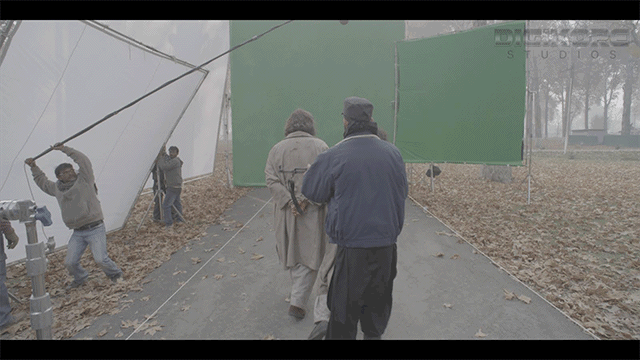
VFX Solution:
For the entire sequence, we shot plates around the bridge without the actors. These plates were shot hand-held, as this was the treatment we had predominantly used in the film.We returned to Srinagar and shot the actors on Green Screen inside the Kashmir University.
In VFX, we composited the Green Screen layers, motion-tracked them with the hand-held plates, colour graded them to give a late evening feel, added muzzle flashes and also created the lighting fall-off over the actor who was firing.
There was also a similar scene involving Shahid Kapoor falling off the same bridge. We repeated the same process. Shot the bridge layers as plates and the actor on Green Screen, and in VFX, composited the shots.
4) Shahid’s speech in Lal chowk
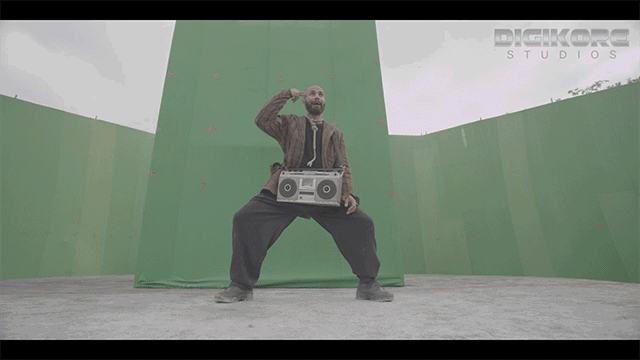
In this dramatic scene, we needed to show Shahid Kapoor giving an emotionally charged speech from an iconic landmark of Srinagar, the Lal Chowk clock tower. This is normally considered a very sensitive spot, with a history of violence. After considering several factors ranging from security to logistics, and the creative limitations such factors could create, it was decided to do this as a VFX sequence.
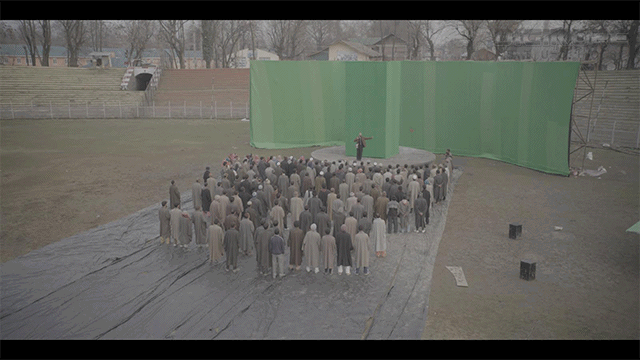
VFX Solution:
The entire sequence was shot inside a well-protected and secured stadium on Green Screen. This was shot hand-held with some dramatic camera moves to further enhance the feel.
Later, early one morning, I shot plates in the real Lal chowk location. I had worked out a unique approach to ensure we could effectively match the complex hand-held motions of the Green Screen layers.
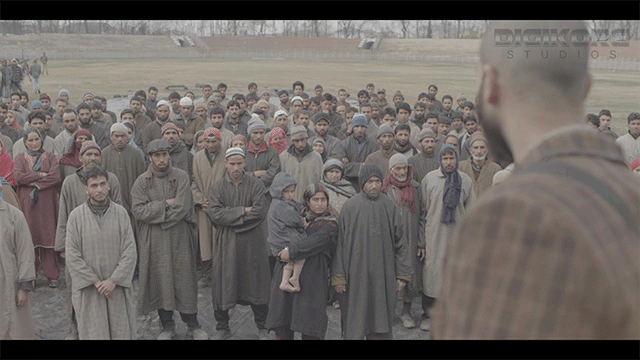
In VFX, the artists did some fascinating work of creating parallax, depth of field, and more.
We also created a CG model of the clock tower since the tower today is quite different from the period we were recreating.
Overall, this sequence would stand out as my personal favourite among all the work done in Haider.
5) Bismil Song
This song was shot on location, and we had a lot of crowd on the first day of shoot. But on subsequent days they disappeared, creating a huge continuity problem. Obviously, we needed to have this crowd, standing on the walls and watching the performance, in all shots.
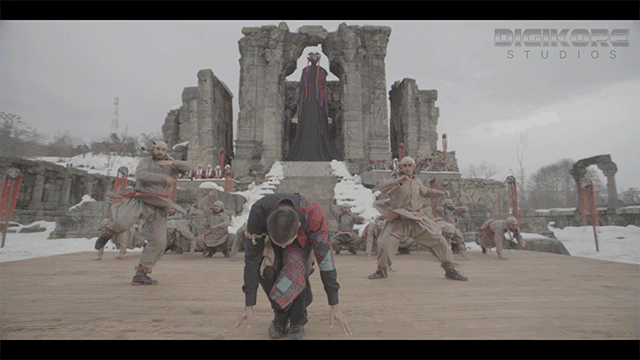
VFX Solution:
Since we didn’t shoot this on Green Screen for practical limitations on set, we had to resort to a massive amount of rotoscopy besides incredible amount of motion-tracking. After the song was shot, I took some random plates of the crowd, and re-engineered them as usable plates in VFX. These plates were then used as layers for compositing over the original shots.
6) Climax scene
a) When the location to shoot the lead up to the climax and the climax itself was finalised, one thing that stood out as a disturbing element was an under-construction hotel. This was a fairly large structure, and we obviously didn’t want this to mar an otherwise perfect setting for the most crucial part of the film.
VFX Solution:
One of the solutions I suggested was that we replace this structure with an authentic looking, equally large structure with a regional design. We agreed on that, and the art department built a fantastic miniature with amazing details and even added patches of fake snow that looked so real.
a) On location, I had the large structure, measuring about 100ft x 80ft and standing 40ft tall covered with a green screen. We filmed all our shots with complete freedom – hand-held, with fog and snow, bullet effects, explosions, etc.
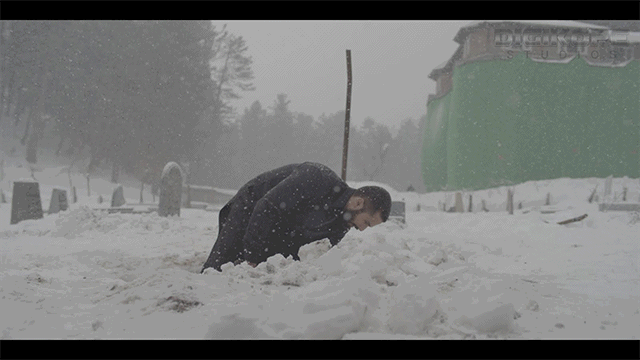
We returned to Mumbai and shot the miniature on Green Screen, and in VFX replaced the location structure with the miniature. This involved some good amount of motion-tracking, projection mapping, fake snow and fog, and very intricate compositing, making sure all elements blended beautifully.
b) In another scene, the large house in which we see Shahid and the others shooting with machine guns had to be blown up by a rocket fired from a shoulder-held launcher.
VFX Solution:
The art department again built a perfect miniature replica of a part of the house.
We shot this miniature on Green Screen in Mumbai, and blew it up. We then composited this layer over live layers shot on location. We also added several layers of debris, fire, and smoke.
In the following cut, we see a man falling down and getting stuck to a collapsed girder. This was almost Entirely CG. The man was a CG double; many of the elements like dust, fire, smoke, etc were all created in CG.
A complex amount of layers went into this one shot to make it look dramatic and believable.
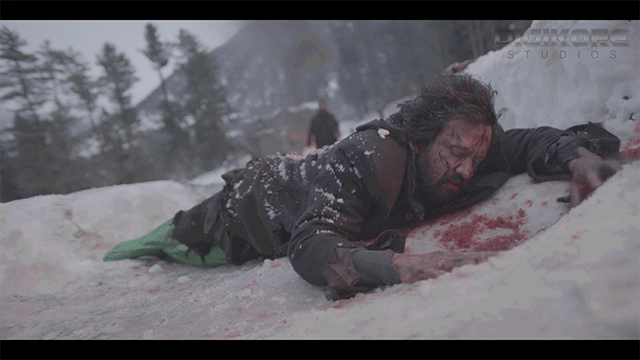
c) Khurram (KK Menon) gets thrown off when Gazala (Tabu) blows herself up. Due to this explosion, his legs were required to be seen chopped off in the following shots.
VFX Solution:
For all these shots, I had the part of the legs that needed to be missing, covered in Green Screen. We then took his shots with absolute freedom. We see him crawling, shaking, as he screams in pain. We even see Shahid stepping over him. In all these shots, we had to see part of his legs missing.
In CG, we created a blood soaked, chopped off part of his legs. We then motion-tracked them intricately and composited them with the actors layers and blended with the torn dress, snow, and blood. We even added a blood trail as he drags himself on the snow surface. The artists worked hard over long hours to pull this entire sequence off so convincingly.
Q. What kind of Pre-viz did ‘Haider’ require and how many days were spent on the post-production? Are you satisfied with the end result and the work by Digikore Studios?
Quite honestly, we did absolutely no Previz, no storyboards. However, we did a detailed recce, discussed and documented some of the key scenes in great detail.
Many post-facilities were analysed for the purpose of executing the VFX in Haider, and finally narrowed down to Digikore. I found them most suitable for various reasons. Firstly, I needed to feel confident and comfortable with the key people who would have to stay committed to the project, and give us all the support needed. Rajeev Kumar, the production head at Digikore had worked in some of the projects I had done earlier, and he was always a very resourceful guy with a tremendous dedication. I knew that with him around, I could count on the kind of support that a big show like Haider very much needed. There was also a tremendous amount of support from another key resource, Roopesh, who was instrumental in ensuring smooth flow of work.
Another important factor is the structure within the organisation. Digikore respects its artists and they had put in a good pipeline, with a very good work-environment that encouraged true talent to flourish. They supported us throughout the VFX and the DI process. In the end, it was a remarkable experience, and everyone’s happy with the way the shots turned out.
Q. What were the most difficult scenes to execute? How did you plan them? Can you run us through them in a little detail?
We divided the scenes between the main unit and 2nd unit, and knew exactly what to shoot, how to shoot. We did a shot breakdown of almost every scene, and improvised to a minimal extent during actual shoot.
The most difficult scenes typically involved outdoor locations. From the production perspective, it was always going to be a huge task to shoot on outdoor locations with actors and other cast. Moving equipment, controlling the crowd, sticking to timelines was always a major concern. Turning to VFX as a solution meant pulling off these scenes more efficiently and creatively satisfying too.
From a creative perspective, I had to adapt to a predominantly hand-held treatment for the entire film. So the VFX shots had to innovate and accommodate the challenges imposed by such an approach. Practically every shot was a moving-camera shot. To pick a few favorites, I would say the tunnel shot of Shahid’s bus, the Baramulla bridge sequence, the Lal Chowk scene, and the climax sequence would have to stand out as the most challenging and exciting to execute scenes.
In the end, I would say the key to the success of the whole production of Haider was ‘planning’. So much coordination between the various departments, inputs from the key crew, some real hard work by the production crew, helped in pulling off a rather challenging task in less than allotted time.
Q. Finally, having been in the industry for so long, what do you feel people can learn from the VFX done in ‘Haider’ and maybe take things a notch higher in the coming years?
One thing about the VFX in Haider is that nobody realised it had any. In my experience I’ve realised that it is far more challenging to execute VFX convincingly in a feature like Haider where you have not a single in-your-face VFX shot. This is no masala stuff. No car crashes. No bike stunts. No choreographed fights. No Bollywood style songs. We are talking of a product that demanded VFX to look absolutely natural, and blend absolutely unseen with the rest of the film. When the film received flattering reviews, it was quite amusing to realise that nobody recognised the VFX that went into making this product happen. On a personal note, what helps me tremendously in pulling off VFX work is the journey I’ve gone through. I had started off as a CG artist, working in TV commercials in the early 90s. Back then, we were a very small bunch of artists doing multi-tasks. I used to do so much CG, and also worked a lot on Flame. I also gained so much experience directing ads and music videos, and had fun doing the post too. I think a VFX designer/supervisor would have to go through this kind of a journey to be effective as a creative head handling VFX of any film. You need to have had a hands-on experience in CG and compositing. You need to know film making too. You need to know the camera, framing, lenses, lighting issues, and be able to relate to the other technicians on the set. And during post, you need to lead from the front. You need to make the artists enjoy working with you. There’s no use in being agitated and abusive, or intimidating the people who are there to work for you.
Abhishek More (President and CEO, Digikore Studios)
Q. Being fairly young in the VFX space and having worked with one of the most respected directors of the Hindi film industry right away; how was the experience and what were the learnings?
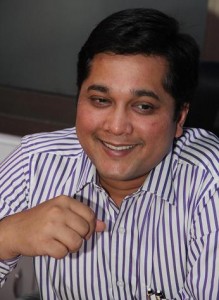 It was a wonderful experience being the first Bollywood venture and with a name which is a class apart. It is always a dream to work with such directors, like Vishal Bhardwaj, who are inspirations for the entire industry. Definitely Haider was a very big project for a recently started studio with a limited team size, still having said so – with the strong production pipeline and our strong technical strengths made this project possible. I’m sure many of the studios would have desired to work on this project, but it was all possible in Digikore because of Govardhan who was the VFX designer on the film from VB Pictures. It was his trust on Rajeev – our Production head who has been working with him very closely in many other projects earlier and in turn his trust on Digikore as a brand in bringing us the project separating us out from the others – has answered for our work ultimately. Rajeev – who is heading the production and operations for Mumbai was always on toes to deliver as per the commitments. And apart from the initial agreed scope of work he was also able to accommodate few more additional shots which was very challenging because the timelines were very stringent.
It was a wonderful experience being the first Bollywood venture and with a name which is a class apart. It is always a dream to work with such directors, like Vishal Bhardwaj, who are inspirations for the entire industry. Definitely Haider was a very big project for a recently started studio with a limited team size, still having said so – with the strong production pipeline and our strong technical strengths made this project possible. I’m sure many of the studios would have desired to work on this project, but it was all possible in Digikore because of Govardhan who was the VFX designer on the film from VB Pictures. It was his trust on Rajeev – our Production head who has been working with him very closely in many other projects earlier and in turn his trust on Digikore as a brand in bringing us the project separating us out from the others – has answered for our work ultimately. Rajeev – who is heading the production and operations for Mumbai was always on toes to deliver as per the commitments. And apart from the initial agreed scope of work he was also able to accommodate few more additional shots which was very challenging because the timelines were very stringent.
Q. Which were the most difficult sequences to execute, and why? Did you mange to stick to a strict timeline and deliver the project on schedule?
With each show you have some new challenges to be tackled. The same was with Haider. Almost all the important sequences of the film were having VFX – be it blast/explosions in the first half or in the second half, Baramullah bridge sequence, Shahid jumping from the bridge, Lal Chowk sequence, Shahid introduction shot (coming out from tunnel) etc… Each of the sequence was carrying a challenge in itself as mostly they were shot against the Green Screen and with the miniatures. The trend of shooting with miniature is not very popular in our industry but you can do a lot with it and can really save on your production cost with unbelievable results. Because it was Govardhan – the execution was really easy as his guidance to the team was of utmost importance and more than any other fact, it is his strong experience in the industry which has made us deliver the great work. I still remember a shot in the film, where we have to show a convoy of the trucks between the valleys of Kashmir and it was requested by the client on priority. It was Govardhan’s strong guidance to the team and with few innovative techniques we were able to deliver the shot which looks photorealistic and like it has been shot by the chopper. For this shot since the time was very less and the expectations were so high that Rajeev had to mobilise more resources shuffling from the ongoing international and other priorities – to execute it faster and the credibility he owes to Govardhan.
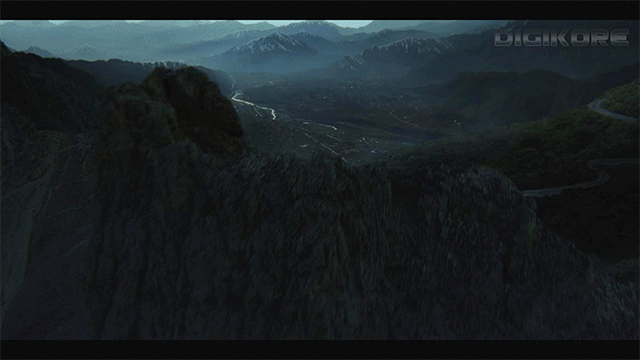
Of course, working within timelines is the requirement of any assignment. In the initial run itself, we were told to complete the job in a month’s time by Govardhan which was practically impossible for the recently started studio like us but thanks to Rajeev and Roopesh, who have been extremely instrumental in balancing the production and creatives because of which we were able to manage the timely deliveries keeping the quality at par with any of the Hollywood projects we work on.
Q. What would be your message to young VFX houses like yourself, who are venturing into this space? What have you learnt in the past three to four years that has made you better equipped to handle bigger and tougher projects in the future?
Believe in your strengths! Do not run into the competition and get yourself dragged into the same league what others might be doing. To be unique has been our strength and we do work considering the fact that we are not repeating anything which is ongoing. Learn from the experiences and create your own Wisden to serve the clients better than the best… There are no shortcuts in Business. Our potentially growing team both on creatives as well as on the technicals has helped us to handle bigger and tougher projects. Top Quality, Great Communication and Commitment to the projects are Digikore’s key principles. Our focus is to create the work environment which people should enjoy and should consider as their next home. Our team gives its best for every project. It is this commitment that has helped us become a leading player in the VFX industry in such a short span of time. Lastly, a message for all my young friends who are willing to be an entrepreneur by starting the studios in this cut throat competition – please take VFX as a potential business and not just a passion, the studio requires lots of efforts from each of the talents who become the part of it to make that studio stand unique in the market, it is tough on both of the ends – to sustain it financially and to maintain the quality standards – when there is no breathing space in the market already.
Q. Now that ‘Haider’ is out of the way, what is the next big assignment on your plate?
Too early to comment on this! But, yes we are presently working on an exciting Hollywood feature film on which we are delivering close to 1,200 shots. We will be starting work on two Hollywood films soon and on the domestic we are venturing into several avenues where creativity is still unexplored. Back home, the next one from us would be Merethuiya Gangster from director Zeeshan Quadri, who is the writer of Gangs of Wasseypur, and then there is this wacky comedy Meet the Patels from Mickey Virus fame Saurabh Varma. These are exciting times for Digikore!

